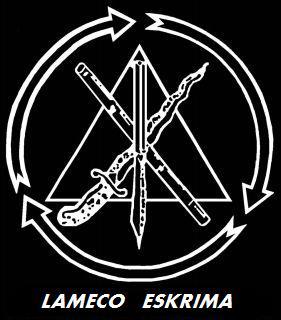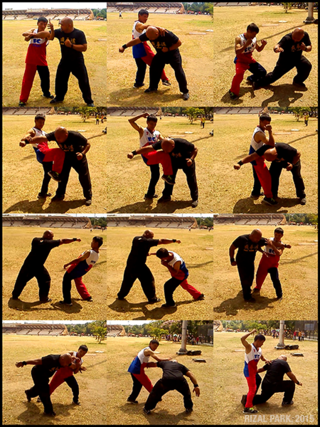
Filipino martial arts (FMA) refer to ancient and newer modified fighting methods devised in the Philippines. It incorporates elements from both Western and Eastern Martial Arts, the most popular forms of which are known as Arnis, Eskrima, and Kali. The intrinsic need for self-preservation was the genesis of these systems. Throughout the ages, invaders and evolving local conflict imposed new dynamics for combat in the islands now making up the Philippines. The Filipino people developed battle skills as a direct result of an appreciation of their ever-changing circumstances. They learned often out of necessity how to prioritize, allocate and use common resources in combative situations. Filipinos have been heavily influenced by a phenomenon of cultural and linguistic mixture. Some of the specific mechanisms responsible for cultural and martial change extended from phenomena such as war, political and social systems, technology, trade and practicality.

Arnis, also known as kali or eskrima/escrima, is the national martial art of the Philippines. The three are roughly interchangeable umbrella terms for the traditional martial arts of the Philippines, which emphasize weapon-based fighting with sticks, knives, bladed weapons, and various improvised weapons, as well as "open hand" techniques without weapons.

Modern Arnis is the system of Filipino fighting arts founded by Remy Presas as a self-defense system. His goal was to create an injury-free training method as well as an effective self-defense system in order to preserve the older Arnis systems. The term Modern Arnis was used by Remy Presas' younger brother Ernesto Presas to describe his style of Filipino martial arts; since 1999 Ernesto Presas has called his system Kombatan. It is derived principally from the traditional Presas family style of the Bolo (machete) and the stick-dueling art of Balintawak Eskrima, with influences from other Filipino and Japanese martial arts.
Doce Pares is a Filipino martial art and a form of Arnis, Kali and Eskrima, that focuses primarily on stick fighting, knife fighting and hand-to-hand combat but also covers grappling and other weapons as well. In reality, the stick is merely considered an extension of the hand, and is meant to represent almost any weapon, from sticks to swords to knives to anything else you can place in your hand and use as a weapon in the modern context. Doce Pares was founded in 1932.
San Miguel Eskrima is one of the major systems of eskrima, a martial arts from the Philippines. Founded by Filemon "Momoy" Cañete of the Doce Pares Club, SME served as vehicle for his own personal expression of the art and methodology of the club of which he was a co-founder and instructor. The name San Miguel is taken from Michael (archangel), the slayer of Satan, and is one of the major strikes used in Eskrima.

Kombatan is a Filipino martial arts system. The founder of the system was GGM Ernesto Amador Presas. The current head of the system is Ernesto Presas Jr. The style is known for its double stick techniques, but it features other stick and blade techniques, as well as empty-hand methods.

Remy Amador Presas was the founder of Modern Arnis, a popular Filipino martial art. Born in the Philippines, he moved to the United States in 1974, where he taught his art via seminars and camps. In 1982 he was inducted into the Black Belt Hall of Fame as Instructor of the Year. He published several books and videos on Modern Arnis and is recognised as the "Father of Modern Arnis".

Balintawak Eskrima or Balintawak Arnis is a Filipino martial art created by Grandmaster Venancio "Anciong" Bacon in the 1950s to enhance and preserve the combative nature of arnis which he felt was being watered down by other styles of Philippine martial arts. It is named after a small street in Cebu where it was founded.
Eskrido, a version of Doce Pares, is a Filipino martial art that is a combination of Doce Pares, Aikido, Ju-Jitsu and Judo, with lesser influences from other Japanese systems. It features standard eskrima stick techniques mixed with Jujutsu-style locks and throws that utilize the stick. The stickwork shows a strong sword influence, and indeed the sword, knife, and other Filipino weapons are also taught. It was founded by Ciriaco "Cacoy" Cañete, who taught it in the Philippines and in seminars across the world. The martial art was established in 1951. Cañete was the highest ranking practitioner in both Doce Pares Eskrima and Eskrido.

Edgar Sulite was a teacher of Filipino martial arts. He was the creator of Lameco Eskrima and trained such notables as Dan Inosanto, Ron Balicki, Larry Hartsell, Fred Degerberg, and Diana Lee Inosanto.

Lameco Eskrima is the system of Filipino martial arts founded by Edgar Sulite based on his training and experience with various Philippine Martial Arts masters, with heavy influence from Jose Caballero and Antonio Ilustrisimo.
Antonio "Tatang" Ilustrisimo was the Grandmaster of Kalis Ilustrisimo (KI), a Filipino martial art bearing his family name.
Bakbakan International is a martial arts association headquartered in Manila, Philippines and founded by Christopher Ricketts. It has chapters in Australia, Canada, and the United States. It also promoted the Masters of Arnis tour in Australia that featured Christopher Ricketts, Antonio Diego, Edgar Sulite, and Rey Galang.

Sibat is the Filipino word for spear, used as a weapon or tool by natives of the Philippines. The term is used in Tagalog and Kinaray-a. It also called bangkaw, sumbling or palupad in the islands of Visayas and Mindanao; and budjak among Muslim Filipinos in western Mindanao and the Sulu Archipelago.
Jose D. Caballero was the founder of a Filipino martial art called De Campo Uno-Dos-Tres Orihinal, also commonly known as De Campo 1-2-3, and is considered the Juego Todo champion of his era.

Kalis Ilustrisimo is a style of Eskrima founded by Antonio "Tatang" Ilustrisimo.
Ciriaco "Cacoy" Cañete was a Filipino martial artist of the Doce Pares Eskrima Club. He was the last surviving member of the club, which was founded in January 1932. He was also a 12th degree black belt. His version of the Doce Pares Eskrima system is known as Cacoy Doce Pares. In 1951 he developed a personal system of his named Eskrido.
Garimot Arnis is a Filipino martial art developed by Gat Puno (Chieftain) Abon "Garimot" Baet. He is the 5th generation inheritor of his family art. Garimot Arnis is a system composed of three basic parts: arnis de mano (weapons), buno (wrestling), and hilot (healing). The defining characteristic of the system is in keeping yourself safe. This is done by meticulously studying the footwork, angles, and distancing of largo mano to keep yourself out of your opponent's range while keeping him in your range. In corto (close) range, the opponent's ability to attack must be shut down as quickly as possible, through a disarm, lock, or manipulation of the opponent's body, which sets up the finish. Above all, knowledge of hilot allows you to keep yourself healthy by helping to fight illness and injuries, especially injuries caused during arnis and buno training.

Suntukan is the fist-related striking component of Filipino martial arts. In the central Philippine island region of Visayas, it is known as Pangamot or Pakamot and Sumbagay. It is also known as Mano-mano and often referred to in Western martial arts circles of Inosanto lineage as Panantukan. Although it is also called Filipino Boxing, this article pertains to the Filipino martial art and should not be confused with the Western sport of boxing as practiced in the Philippines.